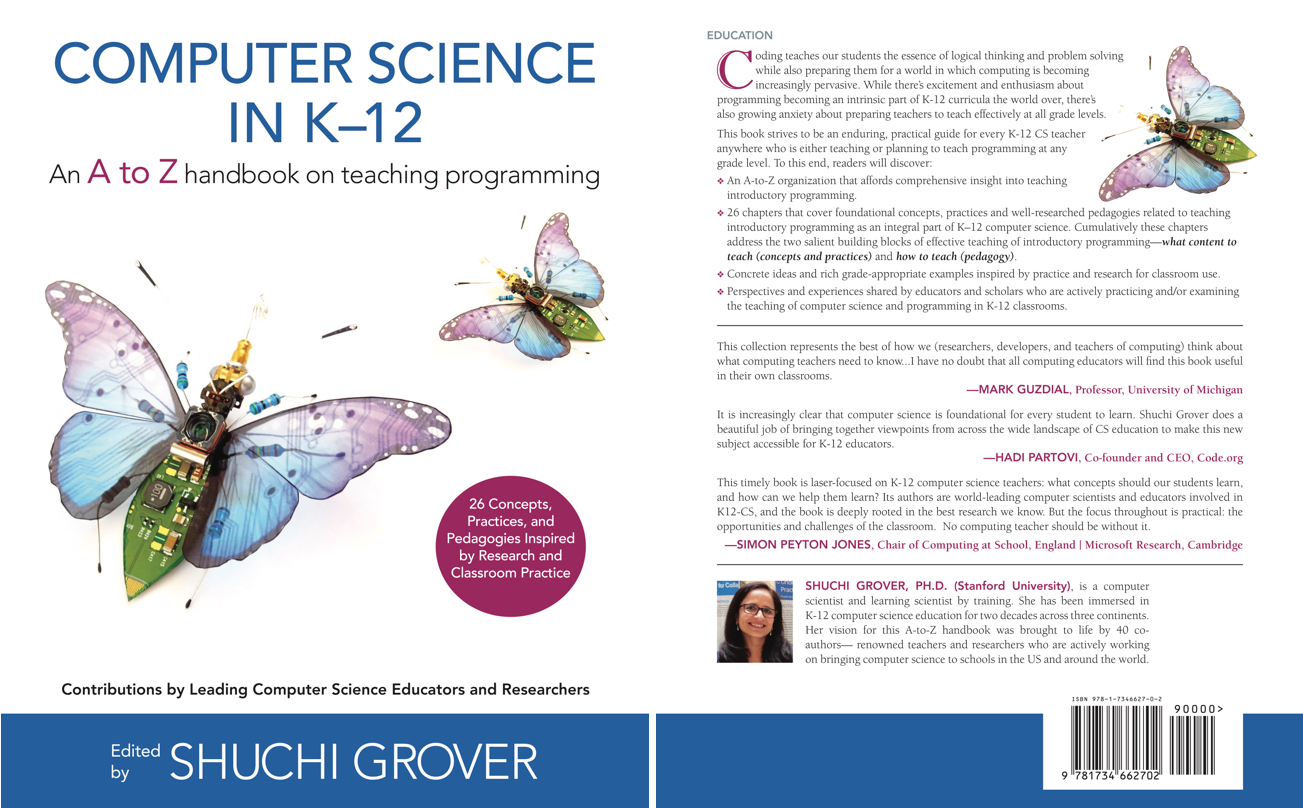Table of Contents | Author Bios | Look Inside
Order today [US]! Paperback (Color-Amazon) | Paperback (Color-B&N) | Paperback (Black & White)

“This timely book is laser-focused on K-12 computer science teachers: what concepts should our students learn, and how can we help them learn? Its authors are world-leading computer scientists and educators involved in K12-CS, and the book is deeply rooted in the best research we know. But the focus throughout is practical: the opportunities and challenges of the classroom. No computing teacher should be without it.” —SIMON PEYTON JONES, Chair of Computing at School, England | Microsoft Research, Cambridge
“It is increasingly clear that computer science is foundational for every student to learn. Shuchi Grover does a beautiful job of bringing together viewpoints from across the wide landscape of CS education to make this new subject accessible for K-12 educators.” —HADI PARTOVI, Co-founder and CEO, Code.org
“This collection represents the best of how we (researchers, developers, and teachers of computing) think about what computing teachers need to know…I have no doubt that all computing educators will find this book useful in their own classrooms.” —MARK GUZDIAL, Professor, University of Michigan
THE NEED FOR THIS BOOK As CS and programming make their way into classrooms across K-12 classrooms and schools, several questions arise for teachers, school administrators and curriculum designers everywhere, regarding teaching this new subject… What should be taught? How should it be taught at various grade levels? What do students typically struggle to learn? How can we support all learners, including those with learning difficulties? How can we make the classroom a fair, inclusive, and learner-centered environment for students from diverse genders, ethnicities, cultures, prior experiences, and backgrounds?
WHAT THIS BOOK IS ABOUT This book is an essential, enduring, practical guide for schoolteachers on teaching introductory programming. It shares concrete examples as well as abstract principles distilled from research studies (our own as well as those of others) and years of experience in teaching CS concepts and practices, and working with pedagogies in introductory CS classrooms. The book comprises 26 chapters that cover the most fundamental concepts and practices and well-researched pedagogies related to introductory programming in K–12 computer science.
However, this book is not a programming primer—it does not teach someone to program. It is designed to teach a teacher to teach programming.
FOR WHOM AND BY WHOM? This book is for educators by educators.
It aims to help current and aspiring K-12 CS teachers build both content knowledge and pedagogical content knowledge (PCK) related to teaching introductory programming.
The audience for this book is any K–12 CS teacher anywhere. Every curious teacher who is preparing to teach, or is already teaching, computer science (and especially programming) in school classrooms worldwide can benefit from this book. The ideas presented here are foundational. They transcend programming languages as well as geographical and other classroom contexts. The book is also helpful for teachers and curriculum designers who may be keen to learn what topics to teach, how to teach them, and of what student struggles and difficulties they should be mindful.
Educators wrote this book—40 educators, to be precise. The authors are either full-time classroom educators in schools and colleges, teacher trainers, or educators who combine teaching of programming with curriculum design and research. These authors represent classrooms in the United States, Canada, UK, Finland, Switzerland, Germany, and Australia. They bring an unparalleled breadth and depth of experience and knowledge gleaned from research, curriculum design, and/or classroom practice at the elementary, middle, high school, and college levels.
BOOK FORMATS: This book is currently available in two formats:



